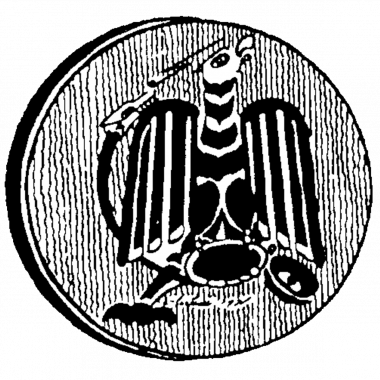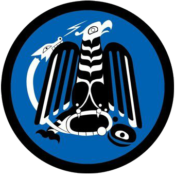
Tseshaht Tiic̓kin Logo
Our logo which was painted by the late George Clutesi Sr., a man of many talents. George was commissioned to paint a mural for Expo 67: wrote several books and acted in a number of films. He was widely recognized for the most important role he played in the revival of Tseshaht culture and traditions.
He expressed this desire in the introduction to his 1969 book Potlatch when he said;
“This narrative is not meant to be a documentary. In fact it is meant to evade documents. It is meant for the reader to feel and to say I was there and indeed I saw.” (George Clutesi, Potlatch, 1969.)
Tseshaht Tiic̓kin Logo
Our logo which was painted by the late George Clutesi Sr., a man of many talents. George was commissioned to paint a mural for Expo 67: wrote several books and acted in a number of films. He was widely recognized for the most important role he played in the revival of Tseshaht culture and traditions.
He expressed this desire in the introduction to his 1969 book Potlatch when he said;
“This narrative is not meant to be a documentary. In fact it is meant to evade documents. It is meant for the reader to feel and to say I was there and indeed I saw.” (George Clutesi, Potlatch, 1969.)
Tiic̓kin (teets-kin) [thunderbird] and his whale hunting allies’ ḥeʔiƛiik (heh-e-etleek) [Lightning Serpents]
In the remote peaks lived Tiic̓kin. He was a huge man, who put on a birdlike outfit to hunt whales. The flapping of Tiic̓kin wings caused thunder and the flicking of his tongue brought lightning. Few had the fortune to encounter him; they more often met his “dogs”, the Ḥeʔiƛiik (Feathered Serpents). Lightning was also made by Ḥeʔiƛiik sometimes one can see evidence by seeing Ḥeʔiƛiik strike a tree and wrapping himself around it. A scale from Ḥeʔiƛiik was an extremely potent charm. Tseshaht once used pebbles from the western shores of Barkley Sound, our oral traditions tell us these hailstones also come from Tiic̓kin creatively represented by George in drawing as squiggly lines.
The first great whale hunter
The story that has been passed down for generations and one that is central to our Tseshaht identity as whalers is the story of Tiic̓kin (thunderbird) who was the first great whale hunter. The flapping of Tiic̓kin wings caused thunder and the flicking of his tongue brought lightning.
There was once four Tiic̓kin that lived in our area, but three of them were killed by Kwatyat (quat-yat), the creator of all things. Tiic̓kin was known to feed on whales. He utilized lightning serpent, as a kind of harpoon or spear to throw at a whale to stun it. Once he had dazed the whale, Tiic̓kin swooped down and picked it up in his mighty claws and took it back to the mountains, where he enjoyed a feast of succulent whale meat and blubber. Tiic̓kin demonstrated that the whale could be caught and utilized for food and tools.
In another version of the story, Tiic̓kin and whale saved our people from starvation. It was a very bad season for fishing and people were having a difficult time finding food to eat. Tiic̓kin saw how hungry we were and went out in search of a whale. He took Ḥeʔiƛiik and wound it around his waist as he flew along the coast hunting for whale. Finally, he spotted one, and he took the Ḥeʔiƛiik and threw it down at the whale, hitting and stunning it. While the whale was stunned, it remained floating on the surface of the water, making it easier for Tiic̓kin to grab. Tiic̓kin dived down, picked up the whale in his powerful talons, and brought it to the village for all the people to eat, so they would no longer be hungry.
“Spirits of Our Whaling Ancestors: Revitalizing Makah and Nuu-chah-nulth Traditions” by Tseshaht, Charlotte Coté
Names of Four Tiic̓kin
Tututʔtš (Tutut-tsh) –meaning thundering now and the only surviving Tiic̓kin
n̓un̓up̓itšmik (nu-nu-pitsh-mik) -meaning catching such (whales) as (come out) once in a while
lulutšʔap (lu-lutsh-ap) – meaning causing to thunder at intervals
n̓up̓itačiƛ (nupita-chitl) –meaning goes out once to sea, as in such a good hunter only needs to go once
In a legend story, the three Tiic̓kin were killed by Kwatyat in revenge of woodpecker whose wife was stolen by Tututʔtš, who also acted in revenge after losing a hoop and spear rolling target game (which was played at feasts). Others that were playing along was bear, crane, kingfisher (the sharp eyed game winner) and Kwatyat (the transformer). It was Kwatyat who killed the three Tiic̓kin in his whaling trickery and he made a whale heavy which drowned the three Tiic̓kin and Tututʔtš the lone survivor.
